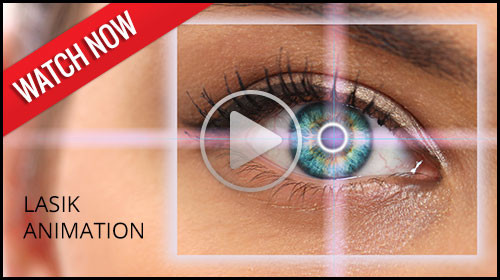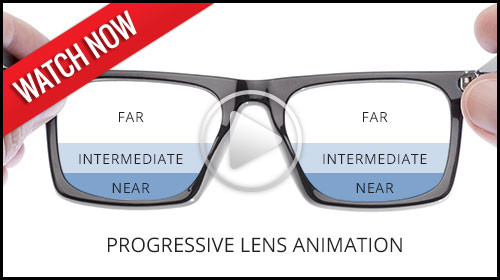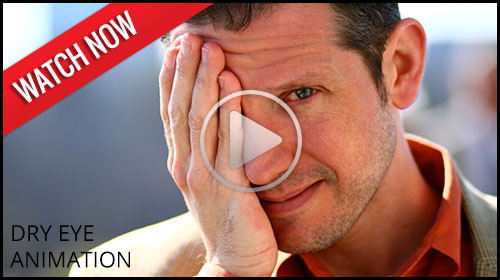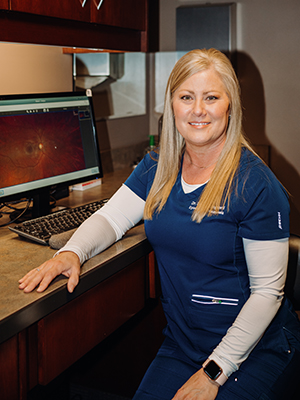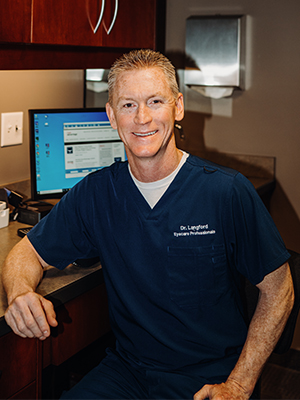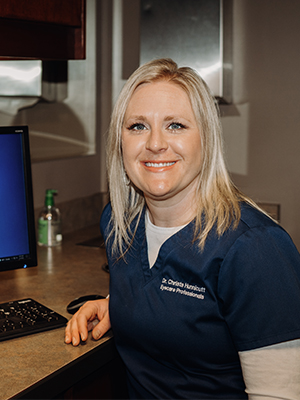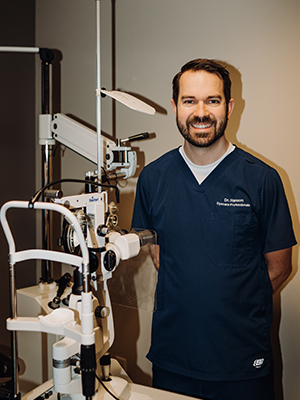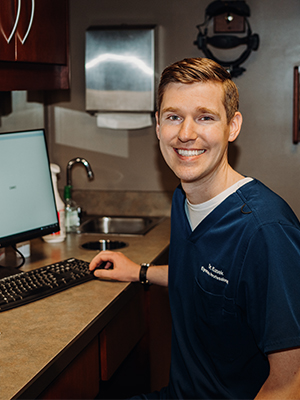Our Services
We Test More Than Eyesight 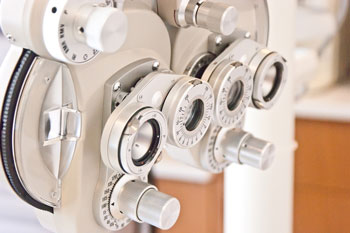
At Eyecare Professionals & Grand Island Optical, the difference in our eye exams is our thoroughness. Our comprehensive eye health evaluations include extensive internal and external eye health, refractive status, and visual effciency assessments. We test more than just eyesight! Our doctors and staff are dedicated to providing a comprehensive eye health and vision examination which may include the following:
- Thorough case history
- Blood pressure screening
- Visual acuity
- Internal health of the eye
- External health of the eye
- Contact lens evaluation
- Cataract evaluation
- Ocular pressures (glaucoma testing)
- Depth perception
- Color vision
- Visual field testing
- Laser vision consultation
- We also provide Treatment of Dry Eye Syndrome - we provide education and services that can help aleviate dry eye symptoms, including replacment options and punctual occlusion.
Vision Correction & Options
At Eyecare Professionals & Grand Island Optical, your vision is our primary concern. We offer vision correction for eye diseases and disorders which prevent you from enjoying the world around you. We specialize in treatment of eye diseases such as macular degeneration, low vision, and cataracts. We also can effectively correct vision conditions, such as myopia (near-sightedness), hyperopia (far-sightedness), and presbyopia.
Our vision correction services aren't just about clear vision - they're about healthier vision. That's why we offer a variety of services including a huge selection of frames, lenses and contact lenses. We can refer you for laser vision correction and vision therapy evaluations.
Eyecare Facts & Myths
Read About Some of the Most Common Myths & Facts About Your Eyes
- Reading in dim light is harmful to your eyes.
- Although reading in dim light can make your eyes feel tired, it is not harmful.
- It is not harmful to watch a welder or look at the sun if you squint, or look through narrowed eyelids.
- Even if you squint, ultra-violet light still gets to your eyes, damaging the cornea, lens and retina. Never watch welding without wearing the proper protection. Never look directly at an eclipse.
- Using a computer, or video display terminal (VDT), is harmful to the eyes.
- Although using a VDT is associated with eyestrain or fatigue, it is not harmful to the eyes.
- If you use your eyes too much, you wear them out.
- You can use your eyes as much as you wish - they do not wear out.
- Wearing poorly-fit glasses damages your eyes.
- Although a good glasses fit is required for good vision, a poor fit does not damage your eyes.
- Wearing poorly fit contacts does not harm your eyes.
- Poorly fit contact lenses can be harmful to your cornea (the window at the front of your eye). Make certain your eyes are checked regularly by your ophthalmologist or optometrist if you wear contacts.
- You do not need to have your eyes checked until you are in your 40s or 50s.
- There are several eye diseases that do not show symptoms that are treatable (most notably glaucoma) that can begin prior to your 40s.
- Safety goggles are more trouble than they are worth.
- Safety goggles prevent many potentially blinding injuries every year. Keep goggles handy and use them!
- It's okay to swim while wearing soft contact lenses.
- Potentially blinding eye infections can result from swimming or opening your eyes under water in a hot tub while wearing contact lenses.
- Children outgrow crossed eyes.
- Children do not outgrow truly crossed eyes. A child whose eyes are misaligned has strabismus and can develop poor vision in one eye (a condition known as amblyopia) because the brain turns off the misaligned or "lazy" eye. The sooner crossed or misaligned eyes are treated, the less likely the child will have permanently impaired vision.
- A cataract must be ripe before it can be removed.
- With modern cataract surgery, a cataract does not have to ripen before it is removed. When a cataract keeps you from doing the things you like or need to do, consider having it removed.
- Eyes can be transplanted.
- The eye cannot be transplanted. It is connected to the brain by the optic nerve, which cannot be reconnected once it has been severed. The cornea, which is the clear front part of the eye, can be transplanted. Surgeons often use plastic intraocular lens implants (IOLs) to replace natural lenses removed during cataract surgery.
Eye Health Evaluation
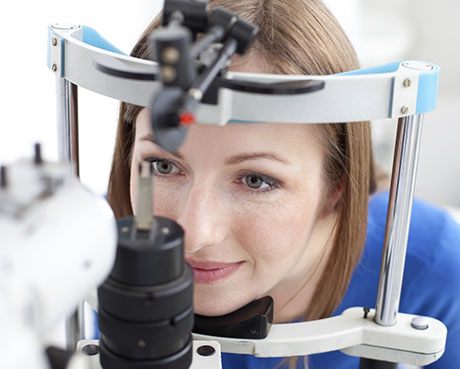
More Than Just Vision Correction!
Did you know that your eyes reveal insights regarding your overall health? In fact, your eyes provide early detection for many different diseases that can affect more than just your vision! That's why we routinely perform tests that look for signs and symptoms of many different diseases, not just eye diseases, during your regularly scheduled eye health evaluation.
Illnesses that may be discovered early on through signs in your eyes include high blood pressure, diabetes, and even heart disease. That's why it's so important to leave your total eyecare to professionals. We feel it's important to review your family history then monitor and watch for signs of possibly inherited diseases or illnesses as another precaution.
What We Check During Your Eye Health Evaluation
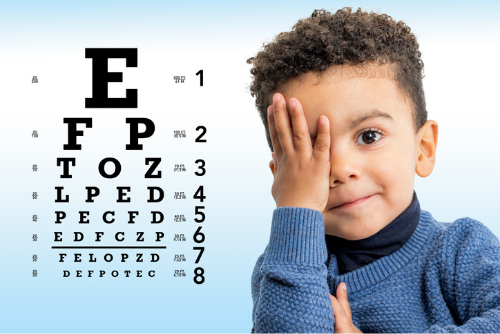 We start by checking your eyesight to ensure that you have the best possible vision you can. If a change in lenses is indicated, we have a fully staffed optical department that can help you with the latest styles and fashions of eyewear available. We also check your intraocular pressures in each eye. Increased ocular pressures are a sign of glaucoma. Early detection of glaucoma is crucial to prevent the loss of sight.
We start by checking your eyesight to ensure that you have the best possible vision you can. If a change in lenses is indicated, we have a fully staffed optical department that can help you with the latest styles and fashions of eyewear available. We also check your intraocular pressures in each eye. Increased ocular pressures are a sign of glaucoma. Early detection of glaucoma is crucial to prevent the loss of sight.
During the exam we also evaluate your external eye health, checking for any growths, infections, drooping of eyelids, or excessive watering. We also evaluate your eye muscle motility to make sure that both eyes are working together and your binocular visual field to check your peripheral vision.
When the doctor performs the slit lamp examination, he is examining your cornea (the transparent front segment of the eye that covers the iris and pupil), the anterior chamber (fluid filled space between the iris and innermost corneal surface), the conjunctiva (thin transparent mucous membrane that covers the eye and the inner surfaces of the eyelids) and the lens (which does the focusing). This part of the examination can reveal cataracts, dry eye syndrome, allergies, infection, and many other conditions.
Dilation of the pupils may be necessary to check for retinal disorders, diabetic eye disease, macular degeneration, and more. If laser treatment is indicated, we can refer you to one of our area Ophthalmologists.
Our Eye Examinations Are The Best
Many bargain eye care providers are interested only in volume and getting patients in and out of the office quickly. Our doctors care about quality above everything else. We want to make sure your vision is the best it can be and that your eyes are healthy. That is why we offer comprehensive eye health evaluations and a variety of treatment options that are performed in our office, along with the necessary follow-up to closely monitor your progress.
Eye Dilation
Have you ever wondered why your eyes must be dilated for an exam? Find out why it's so important to have your pupils dilated. Eye Undilated Eye DilatedDo you think of getting your eyes dilated a nuisance? You're not alone. Most people feel that way. Maybe you've never really understood just why we have to put those annoying drops in your eyes. Here's your chance to find out just why it's so important to be dilated.
Our doctors start your eye exam with a thorough examination of your lids, lashes, conjunctiva, sclera and cornea, all which are the external surfaces of your eye. Using a microscope, or slit lamp, the doctor can get a closer look. When a light shines into your pupil, it constricts or becomes smaller. This is where the dilating drops come into play.
Dilating drops work to keep the pupil widely open so that the doctor can get a much better view of your retina, optic nerve, and vessels in the back of the eye. This is a very important part of an eye health evaluation. From the simple action of putting dilating drops in your eyes, the doctor can gather a lot of important information about your eyes. Diabetes and hypertension (high blood pressure) are sometimes first discovered during a dilated examination.
Make Your Dilated Exam More Pleasant & Comfortable
- Try to avoid planning activities after your appointment that require very clear, crisp vision. Dilation often affects your vision, especially your near vision.
- After dilation, your eyes will be much more sensitive to the light. Bring along a pair of dark sunglasses for the ride home.
- If you think that you may have trouble driving home after dilation, bring a friend or family member to drive for you.
Vision Exams for Children
When is it time for your child to have a professional eye exam? This is an excellent and often asked question.
We recommend the following guidelines. Of course, if any concerns arise at anytime, immediate attention is warranted. Let's face it, nothing is more important than our children's health and development!
At Birth
The attending physician conducts checks for general eye health and signs of any congenital problems.
Milestones
All infants are born with underdeveloped visual systems that have the potential to grow and develop- progressing from a blurry world as a newborn to performing complex visual tasks by the time she reaches school age. Early detection and treatment of eye health and visual problems are essential for proper visual development.
6 Months - 1 year
A thorough eye exam should be done to test for unequal or excessive amounts of refractive error (the need for glasses)- farsightedness (hyperopia), nearsightedness (myopia), and astigmatism, as well as for eye movement ability and presence of eye health problems. This exam can be done without the verbal input from your child!
Milestones
Your child is now starting to focus on near objects, follow moving objects with his eyes, and begin reaching for things. These tasks will increase in accuracy as hand-eye coordination and depth perception develop. His eyes begin to work and focus together laying the foundation for more complex visual skills.
3 years
A full, formal eye health and vision evaluation should be done to measure visual acuity (how clear your child is seeing), test for nearsightedness, farsightedness, astigmatism, and test for eye teaming abilities. At this age, your child is able to participate in formal testing.
Milestones
Both of her eyes should now focus and work together. Her depth perception is becoming more advanced. Distance judgment and the ability to grasp objects with greater accuracy continues to increase. Color vision continues to develop.
Before Entering Kindergarten
A vision exam will assess your child's reading readiness skills. The evaluation will include checking for eye health, visual acuity, refractive error (need for glasses), depth perception, ability to see colors, and eye teaming abilities.
Milestones
His hand-eye and eye/body coordination increases dramatically with depth perception. Vision skills are getting fine-tuned with developing eye teaming skills and fine motor skills needed for the foundation to begin to learn to read and write.
School Age Children
Regular eye examinations are recommended to test for problems that could affect school performance.
Milestones
The basic skills needed for her school years are clear distancee and near vision, peripheral vision, focusing skills, eye teaming skills, and eye tracking skills for speed, accuracy and control of her visual inspection.
Symptoms that May Indicate a Vision Problem:
- Jerking, erratic eye movements or lack of fixation in infants
- Avoiding activities that require near vision or avoiding use of an eye
- Holding objects close to the eyes or sitting too close to the TV
- Using finger to follow along while reading
- Turning or tilting the head or body when performing visual tasks
- Squinting, closing, or covering an eye
- Rubbing or blinking excessively
- Redness of the eyes, excessive tearing
- Reversing words or letters or numbers when reading or writing
- Omitting words or repeating or skipping lines when reading
- Confusing words with similar beginnings
- Performing below potential
Contact Lens Evaluation
Did You Know Poorly Fit Contacts Can Harm Your Eyes?
Few things affect the quality of your life more than your eyes. Please don't put them at risk! Start off right by seeing an eye care professional who provides full-service care in assessing your medical needs, your lifestyle, and the highest quality contact lenses available to meet your needs, and proper training to ensure great vision.
It is important to remember that contact lenses are prescription medical devices. Various brands are designed and manufactured differently. The selection of a particular contact lens needs to be based on your vision problems, prescription, eye health, comfort requirements, lifestyle, age and physiological factors like tear flow. We'll discuss the different lens types and brands with you and advise you about the lens choices that are best for your eyes. Because everyone's eyes and vision needs are different, contact lenses are available with varying schedules for removal and replacement. We'll teach you how to properly clean and wear your new contact lenses to maximize vision and minimize potential risks.
At Eyecare Professionals & Grand Island Optical we make sure that vision correction not only helps you see better, but also helps you feel better. Contact lenses aren't right for everyone, but they may be right for you.
Even if you have astigmatism or need bifocal lenses, we may have a solution. Your evaluation will include:
- A look at your vision history
- An examination of your corneas
- A consultation session with one of our doctors, including recommendations and options
- Our doctors specialize in contact lens care, with special emphasis on hard-to-fit cases and solving problems current contact lens patients may be experiencing.
Call us today for a contact lens evaluation. Enjoy the freedom contact lenses provide!
Youth Myopia Control
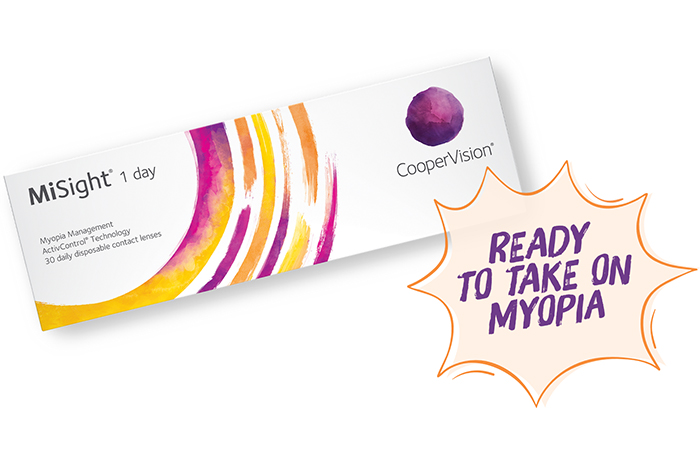
MiSight® lenses by Cooper Vision® are a type of contact lens used to control myopia progression in children. They are daily disposable, soft contact lenses. They're more naturally comfortable to wear, and you can remove them at the end of the day. These lenses come with several advantages: No cleaning is needed since they are disposable.
LASIK Consultation

LASIK, a form of refractive surgery, is an popular option for vision correction, often eliminating the need to wear glasses or contact lenses. Simply put, LASIK reshapes the cornea with a laser.
Other surgical alternatives have become available. Among these is a technique called phakic IOL implantation which involves implanting a lens behind the cornea, but in front of the iris. With this new option, many of those who were too highly nearsighted for LASIK are now candidates for refractive surgery.
If you are interested in refractive surgery, please let us know. Refractive surgery is not to be taken lightly. Detailed testing is necessary to determine whether or not you are a good candidate for the surgery. If testing shows you to be a good candidate, we can help you choose the refractive surgeon who is most appropriate for your case. In addition, we provide post-operative care for refractive surgery.
In-House Lab
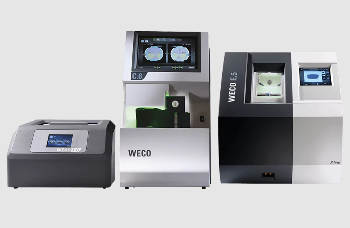
Our In-House lab offers our patients convenience and prompt service.
- Fully equipped optical laboratory to provide eyewear orders for our patients more efficiently.
- Finest equipment used in lens production technology.
- Same day service available within prescription provisions if rush services are required.
- Fully trained and experienced lab technicians consistently providing accuracy and quality.
The doctors of Eyecare Professionals use only the most advanced technology in specialized equipment to provide their patients a precise and accurate diagnostic result and treatment option.
OptiLight by Lumenis® (IPL)
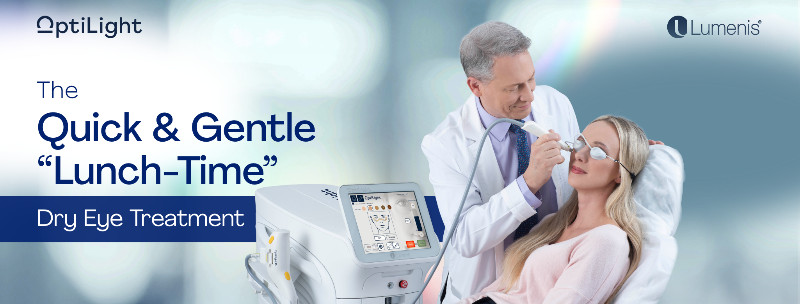
OptiLight by Lumenis® is a light-based, non-invasive treatment done in the area below the eyes to manage dry eye. The first and only IPL FDA-approved for dry eye management. The treatment is safe, gentle, and backed by more than 20 clinical studies.
Oculus® Keratograph
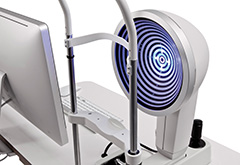
The OCULUS Keratograph® 5M is an advanced corneal topographer with a built-in real keratometer and a color camera optimized for external imaging. Unique features include examining the meibomian glands, non-invasive tear film break-up time, and the tear meniscus height measurement and evaluating the lipid layer.
Download the PDF on OCULUS Keratograph® 5M
TearLab™ Osmolarity Testing

Dry eye is a disease, so performing a TearLab Osmolarity test to determine a proper diagnosis is the first step toward relief.
Osmolarity is the accepted standard for diagnosing Dry Eye Disease. The TearLab Osmolarity Test will give your doctor a meaningful measurement of the health and stability of your tear film. Once your eye doctor has determined your osmolarity number using TearLab, he or she can design a treatment regimen tailored to your specific condition.
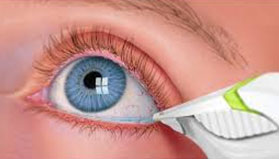
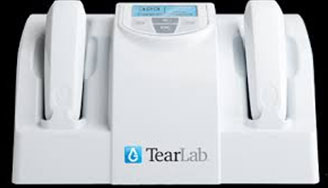
CLARUS 500 from ZEISS®
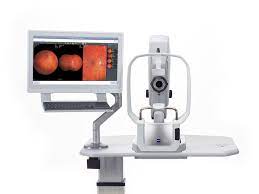
CLARUS 500 from ZEISS® is the first fundus imaging system to provide true color and clarity within an ultra-wide field of view, enabling clinicians to capture high-resolution fundus images from the macula to the far periphery.
By bringing the optics to the patient, ZEISS® CLARUS 500 helps create a comfortable, satisfying patient experience that provides images free of obstructions, such as lids and lashes, and requires fewer recaptures.
Optical Coherence Tomography (OCT)

OCT imaging is clearly the most advanced retinal diagnostic imaging available.
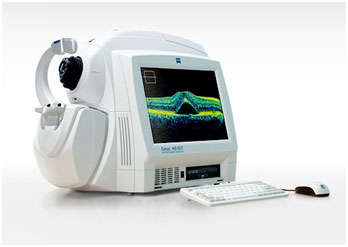
Optical Coherence Tomography (OCT) is a non-invasive imaging test that uses light waves to take cross-section pictures of your retina, the light-sensitive tissue lining the back of the eye.
With OCT, each of the retina’s distinctive layers can be seen, allowing your eye care professional to map and measure their thickness. These measurements help with diagnosis and provide treatment guidance for glaucoma and retinal diseases, such as age-related macular degeneration and diabetic eye disease.
Click for more information on Optical Coherence Tomography (OCT)
Visual Field Analyzer

The visual field test is a subjective measure of central and peripheral vision, or “side vision”.
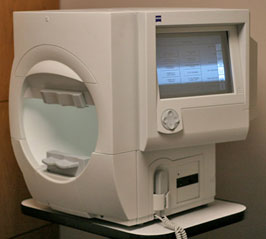
Visual field tests are used to detect blind spots (scotomas), which could be a sign of eye diseases. The size and shape of a scotoma offer important clues about the presence and severity of diseases of the eye, optic nerve and visual structures in the brain. Many eye and brain disorders can cause peripheral vision loss and other visual field abnormalities.
Click for more information on a Visual Field Test

